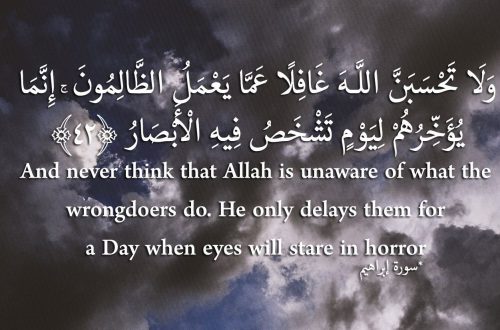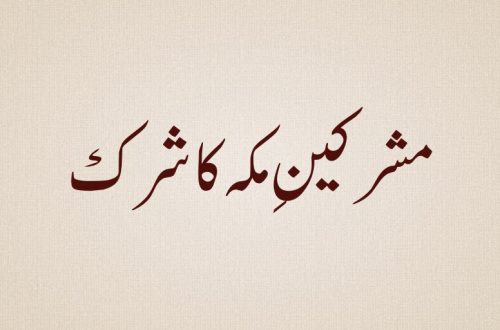By Jon MC
Excursus: “Allah” in Arabia
It might seem odd in this article to write about Allah, or more accurately the word, its derivation and its use, but the more I looked into the language of the Koran in dealing with non-Muslims, the more I came to feel that that understanding of “where Allah came from” was essential.
By the time of Mohammed’s birth in Arabia Judaism had been present for a millennium or more and Christianity for five-six hundred years. In fact, Christianity and Judaism were so widespread that many of the tribes outside Mecca were adherents to one or the other faith (See: http://answering-islam.org/authors/shamoun/preislamic_allah1.html and following parts.) and large parts of Arabia, including parts of the Gulf, were Christian Kingdoms, or perhaps more accurately, kingdoms ruled by Christians.
The word Allah is a contraction of Al-Ilah – “the God” and there is evidence that the word “Allah” came into Arabic from Syriac and arrived with Jews (and was adopted by Christians) centuries prior to Mohammed. The archaeological and other evidence for this is quite compelling.
One theory suggests that, as a result of this, the God of the Bible had been accepted by many non-Jewish and non-Christian Arabs as the Creator-God and installed as their own chief deity whom they worshipped along with the rest of their tribal-gods. Thus “Allah” was the shorthand way of referring to the creator god (and therefore chief god) of the various pantheons, including that at Mecca. Evidence of this is found, for instance, in the name of Mohammed’s father: Abdullah – “slave of Allah” (or “slave of the god”) as well as in a number of pre-Islamic inscriptions, even if little of this Allah’s original Judeo-Christian nature remained.
This may also have been an example of Henotheism, that is the belief in and worship of a single god whilst accepting the existence (or possible existence) of other deities that may also be worshipped. Were this the case, then “Allah” would be the creator-god and his daughters (Al-Lat, al-Uzza and Manat) “demi-gods” or some form of “intermediates”. This latter fits with the “satanic verses” description of “Allah’s daughters” – see below.
Also at the time of Mohammed there was a monotheistic sect called the Sabians living in what is now Iraq. Their confession of faith was “La ilaha ila-allah” (“There is no god but the god”). Mohammed and his followers were sometimes confused with the Sabians because of the Shahada, particularly if emphasis was given to the first phrase. The early Islamic scholar Abd al-Rahman Ibn Zayd wrote:
The polytheists [Meccans] used to say of the prophet and his companions, “These are the Sabians,” comparing them to them, because the Sabians who live Jaziartal-Mawsil (i.e., Iraq) would say “La ilaha ila Allah.”
Interestingly, it would appear that Mohammed co-opted this declaration as the first phrase of the Muslim declaration of faith, the “Shahada”, adding “Muhammadun rasûl-ullâh” (“Mohammed is messenger of god”) to it to assert his prophet-hood.
A second theory is that Allah was the “use-name” for the moon-god Hubal. In the Meccan pantheon, Hubal had three daughters Al-Lat, al-Uzza and Manat (these are the goddesses of “satanic verses” fame – see K.53:19-22 for the “corrected” version) and there are also references to these deities as “the daughters of Allah”; thus it may well be that by the time of Mohammed Hubal had been morphed into the “supreme-creator-god” of the Meccan pantheon.
Note: The “satanic verses” original form was “Have ye thought upon al-Lat and al-Uzza and Manat, the third, the other? These are the exalted cranes (intermediaries) Whose intercession is to be hoped for.” (53:19-22)
There is an interesting piece of evidence within ibn Ishaq‘s biography of Mohammed (“The Life of Mohammed” trans. Guillame, Oxford Univ. Press) p. 67 …“When the man took the arrows to cast lots with them, ‘Abdul-Muttalib stood by Hubal praying to the god” [i.e. praying to “Allah”]. This implies the identity of Hubal and Allah especially given that Abdul-Muttalib was a pagan and ibn Ishaq was himself a Muslim and thus his choice of phrase “…praying to the god” rather than “…praying to that god” or “…that idol” can hardly be deemed accidental. The Muslim argument that Abdul-Muttalib was praying to the Islamic Allah not Hubal falls on the grounds that Abdul-Muttalib was a polytheist and thus not a worshipper of the Islamic monotheistic Allah, nor even a “Hanif” – a proto-Islamic monotheist.
In the Sahih, Ibn al-Musayyib has reported from his father that: “When Abu Talib approached death, Rasulullah [Mohammed] came to him and found Abdullah ibn Abu Umayyah and Abu Jahl in his company. Rasulullah said: O uncle, witness that there is no God but Allah, and thus enable me to plead for you with Him. Abu Talib answered: Would you forsake the religion of Abdul-Muttalib? Rasulullah repeated the request. Adamantly, Abu Talib kept repeating: True to the religion of Abdul-Muttalib! till he expired. Rasulullah said: But I shall continue to pray for your forgiveness as long as I am not prohibited to do so. It was then that Allah revealed the verse: “It is not permitted to the Prophet and believers to pray for forgiveness for the unbelievers.” (K.9:113) and referring to Abu Talib: “It is not you (Muhammad) that guides those whom you love to faith. But Allah will guide whomsoever He wills.” (K.28:56)” (Bukhari; Muslim; Ibn Maajah; Ibn Hibban)
This multiply recorded hadith shows that not only did Abu Talib, an acknowledged polytheist, die a polytheist, but that Abdul Muttalib was one also, since Abu Talib is refusing to forsake the (polytheistic) religion of Abdul Muttalib.
History also relates that Abdul-Muttalib died when Mohammed was eight (or ten) – many years before Mohammed started to preach Islam, thus from history alone Abdul-Muttalib could hardly be seen as praying to an Islamic “Al-ilah”.
Thus by the time of Mohammed, the Meccan polytheists’ “Allah” was well known as the “Supreme Deity” and the other gods were either subordinate or regarded as “facets” of this god, even if the Meccans’ belief reflected little of Jewish or Christian thinking or, come to that, if it was merely the installation of Hubal as “the (chief) god”.
Thus Mohammed changed the Meccan ‘al-Ilah’ – “the (Supreme Creator) god” into ‘Allah’ – “The (only) God”.
Note: It cannot be denied that “Allah” is a title used for god in all three Monotheistic religions. However, because they share a referent, this does not mean that the concepts of Deity are remotely the same. Further, despite much controversy, the argument that Allah = Hubaal (the moon god) is, in my opinion, on somewhat shaky ground – which is not to dismiss it out of hand, merely to state that I think it somewhat less plausible than the use of “Allah” as a use-name (equivalent to “The LORD” as used used by both Jews and Christians for YHWH) – but whether or not “Allah” was a “use name” for Hubaal, there is little doubt that “Allah” as a supreme-creator-god pre-dated Islam.
Evidence for this is found in the Koran itself. Surah 29, v.61-63, this Sura is considered to have been recited in Mecca, pre-Hijra. In it Mohammed is told to ask “them” (here the Meccans) a series of questions about who is the Creator and Provider (of rain etc.), to which “they will surely reply ‘Allah’ ”. The Koran then wonders why they don’t believe in Islam – the religion of Allah. Unless this is pure hyperbole, then “Allah” was the creator-god and, presumably, chief god of Mecca prior to Islam.
Surah 38, v5: “Has he made (all) the gods into One God? This is such an amazing thing!” hints at the same thing – all the gods “made over” into Allah.
Conclusion
In this part I’ve tackled the “big three” Kaffirs, Mushriks (Mushrikoon) and Zalims (Zalimoon).
Already we are starting to see a web-like inter-relationship between the words used to describe “classes” of non-believers. In practice what we are seeing is that these classes merge and totally overlap.
Thus, although “Zalimoon” are literally “wrongdoers”, we discover that all non-believers are “wrong-doers” in some way or other. For example, they “do wrong/harm” simply by not converting to Islam; in this case the “wrong-doing” is their rejection of the “signs” of Allah.
Similarly, although a “Mushrik” is “one who associates others with Allah”, to do this is wrong (Islamically speaking), thus Mushrikoon are, a priori, Zalimoon. Further, we find (again) that all non-believers are “Mushrikoon” since they are all deemed to have their “gods” who are thus set up alongside or – worse – in opposition to to Allah. Thus all non-believers are also Mushrikoon.
“Kaffir” is an umbrella term. It describes those who, through an act of will, practice “khufr” – the refusal to believe in Allah/Mohammed. Except for those who have never heard of Islam and (perhaps) children every person who has refused to believe is a Kaffir and also a Mushrik and a Zalim, with all the negative attributes of both in addition to the negative attributes of a Kaffir.
Note: I use the phrase “negative attributes of” because I know not of a single case in which Kaffirs, Mushrikoon or Zalimoon are described in a positive light in the Koran.




